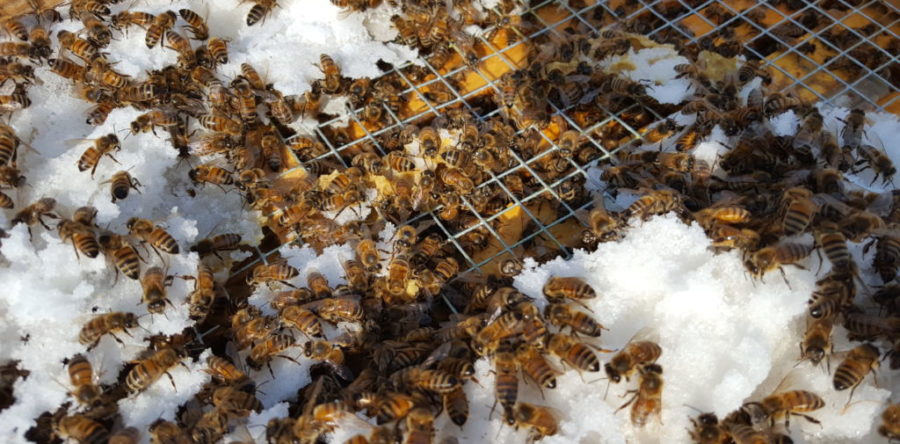Originally submitted by Jim Orem and Ginger Davidson
Revised by J. Morgan
According to the Farmer's Almanac, "Spring is the time when worms begin to emerge from the earth, ladybugs land on screen doors, green buds appear, birds chirp, and flowers begin to bloom. The vernal, or spring, equinox signals the beginning of nature's renewal." It is also the time of year when Mother Nature hasn't really decided what she wants to do and things are very unpredictable. This year is no exception.
This volatility means that the items on your beekeeper 'to do' list depend on what is happening in nature and therefore, it becomes more of an art form. So, get with your mentor and learn from the experience of others. Listen to the sounds and make observations on what is happening in your area and around your hives. Make notes on the flora and fauna.
As the days become warmer and longer, brood production will start to increase inside the hive. Get in them the next time weather allows! Look for eggs... note the number of frames of brood. How's the honey stores? How are your candy boards? Take note of anything else out of the ordinary.
Be intentional on the timing of adding pollen to a colony and don't add it too soon. Remember, pollen stimulates brood-rearing. With brood production comes the need to feed the expanding population of bees. If you have a weaker colony and stimulate them prematurely, they could get the queen laying too fast (outside the cluster,) and not have enough bees to keep the new eggs warm during another cold snap. Nurse bees will not abandon brood, and they will freeze to death. Be choosy about which hives should get pollen, and which you should hold off on. Stronger colonies are more forgiving here.
Don't be caught off guard and ensure that your bees have plenty to eat. Here is another reason I like a candy board on the top of the hive. It's easy to chock a brick or two of sugar in there if it's needed.
This is also the time of year when we hear stories like... "They were just fine last time I checked them. They had plenty of food, ventilation, days to get outside... what happened?" Often times, the answer is that the mites were not in check. Remember, mites vector viruses. By this time, bees that have had unchecked mite levels going into the winter are likely very sick right now. In their weakened state, one cold snap can easily take them out. If you are not measuring the mite activity in your hives, you are cheating yourself and your bees. This is not meant to discourage you. It's an easy thing to do. If you have questions, just ask us!
What a beekeeper should be doing in March:
- Finish up new boxes, repair/paint any other woodenware that need it, and be sure your honey supers are ready to go.
- Prepare your swarm traps. Swarm traps go out in April. Likely sooner this year! Order swarm lures or try lemongrass oil.
- If it isn't too cool, perform a quick inspection to see if you have bees, larva, eggs, and a queen. Remember, if you see eggs, with 1 per cell, there is a queen. If you see poor brood patterns or a colony is just not building up like the others, it might be prudent to plan to pinch the queen (around or after Mother's Day) or combine this hive with a good one using the newspaper method.
- If you have been keeping pollen patties in the hive, beware when weather warms up, unused patties will attract small hive beetle.
When the imminent threat of bad weather is behind us
When the weather is warm (ideally 50F or higher):
- Some may choose to move brood frames to the bottom of the box, honey to the sides and empty comb overhead. Do not disturb the cluster too early though as this can result in chalkbrood. Make sure also that the bees are not straddling two boxes. A blind reverse could split the brood chamber in two and that will be bad during another cold snap.
- Clean the bottom boards.
- Eventually, when the bees are waiting in line to get inside the hive, enlarge your entrances... or remove entrance reducers completely at your discretion.
- At the end of March, remove candy boards and if needed, start feeding 1:1 sugar water and pollen. If the bees didn’t eat the candy boards, store them in the freezer, or use it in your spring sugar water feed.
- Watch for drones and queen cells. This will be the bees way of telling us that it is the time to start making splits.
Right now, take any warmer days to look inside your hives. Get into them once a week if weather allows. Take notes of what you see. New beekeepers especially. This information can be meaningful to you (and your mentor if they ask you things) later. It's a big time for the bees right now. Really strong hives that are doing what they should are about to explode. Bring your questions to a meeting!




6 Responses